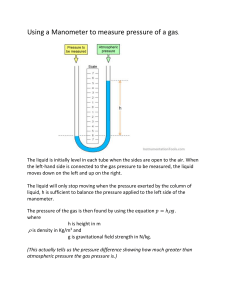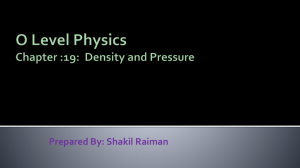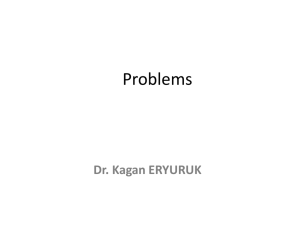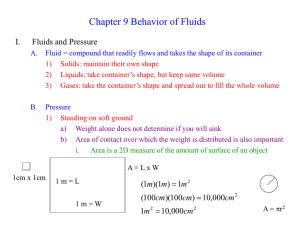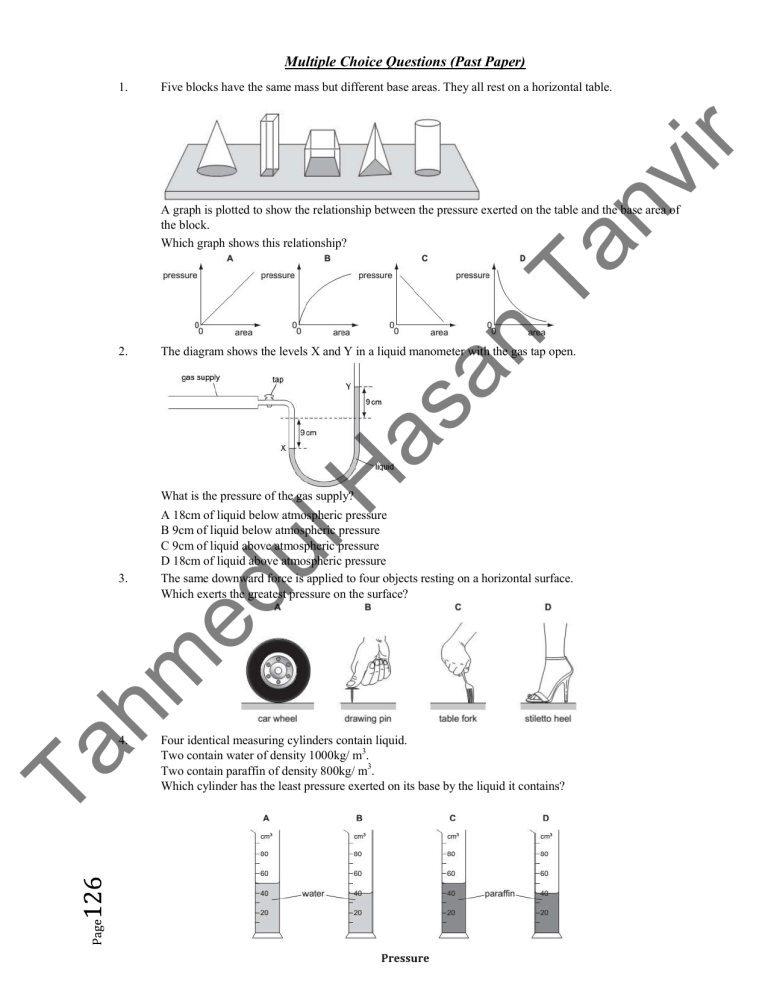
Multiple Choice Questions (Past Paper) Five blocks have the same mass but different base areas. They all rest on a horizontal table. vi r 1. The diagram shows the levels X and Y in a liquid manometer with the gas tap open. ul H 2. as an Ta n A graph is plotted to show the relationship between the pressure exerted on the table and the base area of the block. Which graph shows this relationship? What is the pressure of the gas supply? Ta h m ed 3. A 18cm of liquid below atmospheric pressure B 9cm of liquid below atmospheric pressure C 9cm of liquid above atmospheric pressure D 18cm of liquid above atmospheric pressure The same downward force is applied to four objects resting on a horizontal surface. Which exerts the greatest pressure on the surface? 4. Four identical measuring cylinders contain liquid. Two contain water of density 1000kg/ m3. Two contain paraffin of density 800kg/ m3. Which cylinder has the least pressure exerted on its base by the liquid it contains? The diagram shows a mercury manometer connected to a gas container. Ta n vi r 5. The density of mercury is 13600kg/ m3. The gravitational field strength g is 10N/ kg. What is the pressure difference between the gas in the container and the atmosphere? A 27200Pa B 40800Pa C 54400Pa D 81600Pa A partially-inflated balloon is placed inside a bell jar. The bell jar is connected to an air pump. as an 6. A brick of weight 80 N stands upright on the ground as shown. Ta h m 7. ed ul H The air pump is switched on and air is removed from the bell jar. What happens to the pressure and to the volume of the gas inside the balloon? 8. What is the pressure it exerts on the ground? A 0.080N/ cm2 B 0.40N/ cm2 C 0.80N/ cm2 D 1.6N/ cm2 An airtight container holds a fixed mass of gas. Its pressure and volume are measured on four occasions when the temperature is 20 °C. The results are shown in the table. Three sets of readings are correct. Which set of readings is not correct? The diagram shows a manometer containing mercury that is sealed at one end. Ta n What happens to the distance h when the manometer is taken to the top of a mountain? A It decreases, because atmospheric pressure decreases with height. B It decreases, because atmospheric pressure increases with height. C It increases, because atmospheric pressure decreases with height. D It increases, because atmospheric pressure increases with height. vi r 9. A gas occupies a volume of 2.0m3 in a cylinder at a pressure of 240kPa. A piston compress the gas until the volume is 0.50m3, the temperature remaining constant. What is the new pressure of the gas? A 60kPa B 240kPa C 480kPa D 960kPa 11. The base for a statue rests on level ground. It is made from stone and is 2.0 m long, 2.5 m high and 0.80m wide. It has a weight of 96 000N. ul H as an 10. What is the pressure that the base exerts on the ground? A 19kPa B 24kPa C 48kPa D 60kPa An engineer designs a dam wall for a reservoir. ed 12. Ta h m Which factor determines the pressure at X? A the depth of the water in the reservoir B the surface area of the reservoir C the length of the reservoir D the thickness of the dam wall 13. The diagram shows two identical pieces of apparatus. One is filled with water and the other is filled with mercury. Water is less dense than mercury. At which point is the liquid pressure greatest? Objects with different weights are placed on a rigid, horizontal surface. Which row shows the correct pressure acting on the surface? 15. A garden table weighs 40N and has a top surface of area 2m2. It is raining and the rain produces a pressure of 4N/ m2 on the table. What is the force exerted by the table on the ground? A 20N B 32N C 42N D 48N Ta n vi r 14. Four syringes contain air at atmospheric pressure. The air in all four syringes is slowly compressed. The results are given in the table. Which syringe shows the smallest pressure change? 17. Four different liquids are poured into identical measuring cylinders. The diagrams show the depths of the liquids and their densities. ul H as an 16. m ed Which liquid causes the largest pressure on the base of its measuring cylinder? Ta h 18. A manometer is attached to a gas cylinder as shown. What is the pressure difference, in cm of water, shown by the manometer? A9 B 16 C 20 D 25 The diagram shows a simple manometer that contains a liquid. vi r 20. Ta n Objects of different weights are placed on a rigid, horizontal surface. Which row shows the correct pressure acting on the surface? as an 19. Side X is connected to a gas supply of pressure R. Side Y is open to the atmosphere at pressure S. AR BS CR S DR+S Air is trapped in a cylinder by a piston. The pressure of the air is p and the length of the air column is 20cm. The piston is moved outwards until the length of the air column has increased by 40cm. The temperature of the air remains constant. ed 21. ul H Which pressure is the length h used to measure? m What is the new air pressure? Ta h 22. A builder leaves two identical, heavy, stone tiles resting on soft earth. One is vertical and the other is horizontal. After a few hours, the vertical tile has started to sink into the soft earth, but the horizontal one has not. Which row correctly compares the forces and the pressures that the tiles exert on the earth? vi r A water manometer is connected to a gas supply. One end of the manometer is open to the atmosphere. The diagram shows a simple model of the braking system of a car. A force of 20N is applied to piston P. As a result, there is a force F on piston Q. ul H 24. as an Which statement about the pressure of the gas supply is true? A The pressure is hcm of water. B The pressure is h cm of water below atmospheric pressure. C The pressure is the same as atmospheric pressure. D The pressure is h cm of water above atmospheric pressure. Ta n 23. Piston P has an area of 5.0cm2 and piston Q has an area of 25cm2. What is the force F? A 4.0 N B 20N C 100N D 500N The diagrams show liquids in containers. Which column of liquid exerts the greatest pressure on the base of its container? Ta h m ed 25. 26. A long tube full of mercury is inverted in a small dish of mercury. The mercury level in the tube falls, leaving a vacuum at the top. When the atmospheric pressure falls, which length decreases? A PQ B PS C QR D RS Some gas is trapped in a large syringe by a piston. The atmospheric pressure is 100kPa. vi r 27. The pressure gauge indicates that the gas pressure is 200 kPa above atmospheric pressure. The piston moves outwards and the volume of the trapped gas doubles. The temperature remains constant. A 100kPa 28. B 150kPa C 200kPa D 400kPa Which statement about the pressure in a column of liquid is correct? 29. An airtight container holds a fixed quantity of gas. Its pressure and volume are measured on four occasions when the temperature is 20°C. The results are shown in the table. ul H Which set of readings is incorrect? The diagram shows a simple model of the braking system of a car. A force of 20N is applied to piston P. As a result, there is a force F on piston Q. m ed 30. as an A It acts only vertically downwards. B It increases if the column width increases. C It increases with depth in the column. D It is uniform throughout the column. Ta n What is the new gas pressure? Piston P has an area of 5.0cm2 and piston Q has an area of 25cm2. Ta h What is the force F? 31. A 4.0 N B 20N C 100N D 500N The graph shows how the pressure of a fixed mass of gas varies with volume at constant temperature. What is the volume of the gas when the pressure is 25kPa? A 2.5cm3 B 10cm3 C 30cm3 D 40cm3 The diagram shows a simple manometer. vi r 32. Ta n Side X is connected to a gas supply. Side Y is open to the atmosphere. What pressure is the length h used to measure? The diagram shows the principle of an hydraulic system. ul H 33. as an A the atmospheric pressure S B the difference between the gas pressure R and the atmospheric pressure S C the gas pressure R D the sum of the gas pressure R and the atmospheric pressure S The cross-sectional area of the master cylinder is 12.0 cm2 and the cross-sectional area of the slave cylinder is 8.0 cm2. The force applied to the master piston is 60 N, producing a pressure of 5.0N/ cm2. m ed Which line in the table is correct? Ta h 34. Some gas is trapped in a large syringe by a piston. The atmospheric pressure is 100kPa. The pressure gauge indicates that the gas pressure is 200 kPa above atmospheric pressure. The piston moves outwards and the volume of the trapped gas doubles. The temperature remains constant. What is the new gas pressure? A 100kPa B 150kPa C 200kPa D 400kPa A block of weight 900N has rectangular faces. The diagram shows the lengths of the sides. vi r 35. The block can rest on any of its faces. A 900Pa C 6000Pa A U-tube containing water is used as a manometer. D 7500Pa ul H as an 36. B 4500Pa Ta n What is the minimum pressure that the block can exert on the ground when resting on one of its faces? When one end of the manometer is connected to a low-pressure chamber, both water levels in the manometer change by 20cm. The gravitational field strength g is 10N/ kg. The density of water is 1000kg/m3. ed How far below atmospheric pressure is the pressure in this chamber? A 2000Pa C 200000Pa D 400000Pa A gas is trapped inside a cylinder by a movable piston. The length of the gas column is 20cm and the pressure inside the cylinder is p. Ta h m 37. B 4000Pa The piston is pulled out a distance of 30cm, so that the length of the gas column is now 50cm. The temperature of the gas does not change. What is the new pressure of the gas? A 0.40p B 0.60p C 1.5p D 2.5p
